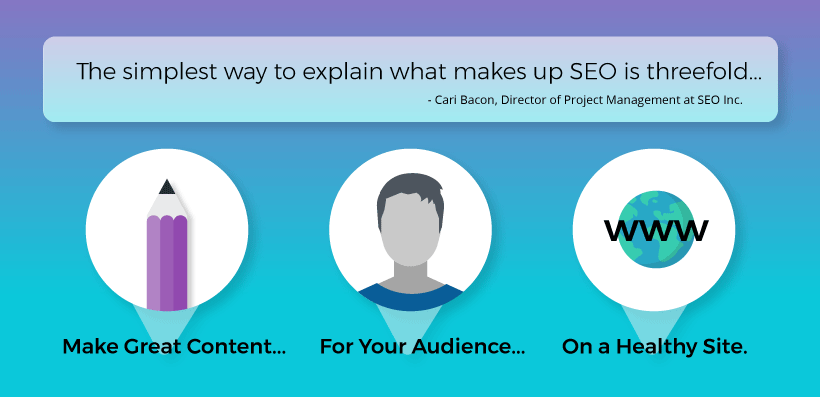When Google decided that a key factor in assigning domain authority would be the quality and post frequency of a URL’s original content, content marketing became not just a potential marketing strategy, but a crucial one. This is much to the consternation of many marketers, especially those who are more analytical and less creative.
Why does every brand in every industry, from insurance to fashion to healthcare, need to be an online publisher in addition to selling product? It’s a fair question, but not one that can be concluded with a zero-content marketing strategy. Not at this time, and not in the foreseeable future.
“The simplest way to explain what makes up SEO is threefold,” says Cari Bacon, Director of Project Management at SEO Inc.
1. Great content…
- This doesn’t have to be very long, but it helps to make it relevant, useful, entertaining, and authoritative.
- Know who you want to have as clients. What are they looking for?
- Take care of your site, make sure it doesn’t have broken links, or hasn’t been hacked.
With SEO leaders like SEO Inc taking this approach, a lot of companies are (if grudgingly) earmarking nominal budgets for original content, with intentions that it’ll be quality enough to appease the Google algorithm. However, some growth-hackers and optimistic SMB owners are still searching for a shortcut: a way to trick the algorithms. This mindset is certainly not new, but experts agree that it’s less feasible in 2018 than ever before:
“In the past year or two, Google has rapidly ramped up their sophistication, technologies, and focus on the searcher/consumer,” explains Shelly Cihan, Director of Search Marketing at Adworkshop in New York. Google’s noticeable shift toward “putting more prevalence on the features that provide users answers directly within the search results” is definitely changing the web-browsing experience for users.
For marketers, it’s more of a marching order:
“Quick hacks and lazy content will no longer provide value to a business,” sums up Cihan.
For every established marketing agency or consultant that gives this outlook, there’s a guy on Upwork or Facebook Ads promising a quicker/cheaper way. Even among more experienced marketers, there exists a “try everything because you never know what might work” mentality. And in some respects, I agree with that mentality… as long as you understand the risks involved… i.e., that your business might be buried in the search rankings, a manual penalty placed on your website, or one of your social channels deactivated by a platform.
Even if you’re a numbers person who never read anything just for fun in their life, please heed this expert advice and stay away from the following bad hacks and long shortcuts around content. Unless you don’t mind rolling your Monopoly dice and possibly landing in Google jail.
Bad hacks and long shortcuts to avoid… Don’t listen to anyone who tries to sell you on them.
1. Buy cut-rate backlinks on random high-authority sites.
“Can we put this awful theory to rest that all that matters in rankings are the number of links leading back to your site? This was the case over a decade ago, but that tactic has gone the way of the dodo,” says Cari Bacon.
A slew of links pointing to your site, from sites that do not relate to your offering, is a sure way to get a penalty from the search engines, she says. It is more important to have quality links from other sites.
“Think of buying links using this analogy: If you hang out with the ‘bad’ kids while in school or they talk about you a lot, the teachers will start to see you as a bad student by association. The same goes for positive association. Your site is judged by who is ‘hanging out’ with it, linking back to it, and discussing it.”
2. Expect to see results of a link-building campaign within the month.
“Google does not want you to rise in rank fast, especially if you do anything that is related to healthcare, finance or other verticals that have higher consumer risk and thus get higher scrutiny,” says digital marketing and SEO consultant Scott Frankum. “Search engines believe that protecting searchers from potential scams is part of their sustainable competitive advantage.”
So even if you’re not a scammer, just an honest business person trying to monetize online, “Building quality consistently is the only way forward,” according to Frankum and other experts I spoke to.
3. Pay for influencer content, but have no strategy for repurposing/using it.
It’s downright baffling to me how many marketing people and business owners are obsessed with “reach” — that component of an influencer’s offering which has been publicly shown 100 times over to be unreliable and easily manipulated — but not interested in utilizing the high-quality content they get from the partnership.
Even while influencers are switching their title to “content creator” in droves to stay away from the entitled grifter stereotype, there are many brands out there who see influencers only for their potential platform. These brands pay attention long enough to know that the influencers indeed posted some piece of content on the contracted channels — and then never think about reposting or repurposing a single piece of said content… even if they bought it outright.
There are a lot of companies that do understand how to use influencer content for everything from owned blogs and newsletters to IG Story Highlights to hilarious commercial spots. To anyone who’s not repurposing their influencers’ content even for the brand’s own social channels — that is the definition of half-hearted influencer marketing, not to mention a waste of resources.
4. Expect your SEO specialist to handle the content.
SEO is an all-consuming role. I’ve seen SEO specialists that were dynamite at creating topics from keywords, and even seen SEO specialists that understood Pinterest and Instagram better than most marketing directors — because of similarities in algorithm behavior. That said, an SEO specialist is usually tasked with running PPC campaigns, managing keyword lists, monitoring the competition’s rankings, looking for optimization opportunities and a crushing load of other SEO-specific tasks. They don’t have bandwidth to be writing snappy blog posts and product copy. Look to them to provide topics and page optimization, but not to handle both roles.
“When you think of content in terms of building quality, it can be a great idea to partner copy and SEO because in the coming Internet, they start to merge,” says Frankum. “Creative works, local businesses, products, events and more all get a big boost in functionality (and rank) from Structured Data SEO.”
5. Hire a content consultant and tell them to figure out the topics with no input from anyone else at your company.
No matter how experienced and skilled a freelance creative may be, they are not psychic. Especially if there’s no existing branding or voice for them follow, a content creator who’s new to your company — especially if they’re an external resource who’s not seeing the company culture — has about a 5% chance of nailing exactly what you want on the first attempt. And most experienced freelancers have a one or maximum two-revision limit built into their per-post price.
If for whatever reason the company founders/executives don’t want to provide any content direction whatsoever, connect the creative with the SEO specialist, as mentioned above, or with the PR and marketing internal teams or agencies.
6. Putting other people in the company to work part-time creating content because they always wanted to write/photograph/design.
I’ve seen this with large and mindless companies who don’t value content, and I’ve seen it with small family-owned ones who genuinely wanted to provide their employees with an opportunity. (Yes, there was an element of penny-pinching in both scenarios.) To anyone who might think on doing this, I ask:
- Would you “give a chance” to paint your car to a tax accountant who had never painted a car before?
- Would you hire a handyman to highlight your hair?
I’ll stop with the ridiculous questions. The answer is always no, and it is with content creation as well.
7. Deploy bots with abandon (or allow an agency to do so).
Not sure what a bot is? Here’s an easy way to know whether you’re being sold one: Any service that promises a certain number of new followers, immediate engagements, or inexpensive “a la carte” SEO services is using bots to get results. Buy in haste, and deal with tens of thousands of junk followers or dangerously low-quality links in the future.
“If black hat tactics ever worked, they sure don’t work now and might get your site put into Google [Facebook, Pinterest, Instagram] jail,” says Frankum.
8. Look for a “set it and forget it” endpoint.
“SEO is NOT something you can ‘set and forget,’” says Cari Bacon. “The engines, whether Google, Bing, or Duck Duck Go, want content that is up-to-date and fresh.”
While some core content pages may be evergreen, her practice is to ensure most of the pages on a client’s site are updated often to show the engines that it is still “alive.” And the rest of our experts corroborate: Google wants you to be an active publisher of quality content on a fast, healthy website.
“In early days of the Internet, the problem used to be a lack of information or data in silos. Today, the problem is too much data,” says Frankum. “Given that, what should search engines do to meet the challenge of too much information? Google’s answer was to become a tiger mom, who always wants better from us.”








